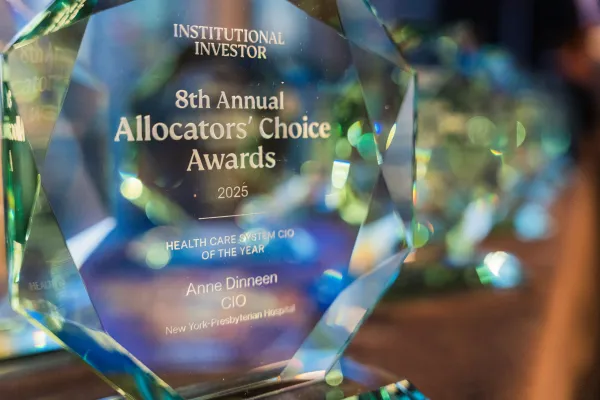After a year marked by trade wars, historic market volatility, and questions about what once seemed immutable — the U.S. dollar as the world’s reserve currency and the independence of the Federal Reserve — it is time to recognize the best and brightest professionals who provide inspiration and leadership and will help guide the industry through the next few years of uncertainty.
With that in mind, II is proud to provide the names of the finalists for Endowment/Foundation CIO of the Year, Health Care System CIO of the Year, Public Pension CIO of the Year, and the Award for Leadership and Vision.
Next week, we will announce the nominees for Insurance CIO of the Year, Single Family Office Investor of the Year, Corporate Pension Plan of the Year, and Asset Manager/Allocator Partnership of the Year. And that’s when the voting will begin.
The editorial team vetted and selected finalists from a pool of nominations submitted by the industry and from names identified through its own independent research. We’d like to thank members of our awards advisory board for their guidance through a complex process: Chris Ailman, founder and CEO of Ailman Advisers and former CIO of the California State Teachers’ Retirement System; Brian O’Neil, a consultant and former CIO of the Robert Wood Johnson Foundation; and Jonathan Hook, a GP and LP coach at Capital Allocators and former CIO of the Harry and Jeanette Weinberg Foundation.
Winners will be announced on September 18, 2025, at a gala at the Mandarin Oriental in New York City. You can register here.
Next up will be the announcement of II’s Allocator and Hedge Fund Lifetime Achievement Awards and Rising Star winners.
Health Care System CIO of the Year
Stan Ra, CIO of Seattle Children’s, has been the driving force behind the hospital’s investment strategy since 2016. As the organization’s first dedicated chief investment officer, Ra built the investment office from the ground up, instilling a culture of disciplined, collaborative decision making. Under his leadership, the portfolio has grown into a resilient, alternatives-driven engine that balances strong returns with long-term sustainability. With a background in hedge fund investing and a deep commitment to mission-aligned stewardship, Ra has helped ensure that Seattle Children’s financial foundation remains as innovative and forward-looking as the care it provides.
Philip Rotner, CIO of Boston Children’s Hospital, developed the health care system’s investment program from its inception in 2010. As the first CIO of the world's No. 1 pediatric hospital, Rotner built a top-tier private equity portfolio, made strategic health care investments, and built a high-performing team — while consistently delivering strong returns and supporting the hospital's mission of treating sick children, even during the pandemic and the market volatility of 2022. In fact, Rotner is credited with creating the investment model for children’s hospitals across the country.
Fred Greear, CIO of Carilion Clinic, delivered excellent multiyear returns while managing difficult operating budget issues. He transformed the clinic’s portfolio — restructuring governance, adopting a 60-40 benchmark, and bringing management in-house. With a lean team he built from scratch, Greear has driven resilient performance, remote talent integration, and committee collaboration.
Anne Dinneen, CIO of New York–Presbyterian Hospital, has demonstrated remarkable success in managing endowments and fostering financial stability. Industry insiders admire her rebuilding of the health care system’s investment team and portfolio after joining just three years ago. Dinneen previously grew Hamilton College’s endowment 63 percent during her tenure as CIO by boosting alternatives and launching an in-house private equity team.
Kathleen Jacobs, CIO of RWJBarnabas Health, redefined what it means to be a health care investment leader. She has been at RWJBH for only about a year and a half, but the industry is already taking notice of her accomplishments. Thoughtfully adapting her experience from New York–Presbyterian and New York University, Jacobs worked with health care system members to reorganize the portfolio to suit the nuanced needs of RWJBH. Within four months, she built a seven-person investment office from the ground up. In the first six months on the job, Jacobs implemented an investment policy that enabled her team to reorganize the portfolio — which they promptly did. This included restructuring the $4.5 billion portfolio into a liquidity reserve and a long-term fund while boosting equity exposure. Under Jacobs, the team executed about $5 billion in investment decisions, enhancing returns without compromising safety. Her leadership, long-term thinking, and commitment to talent make her a standout CIO in the health care allocator community.
Endowment/Foundation CIO of the Year
Dave Morehead, CIO of Baylor University, has shown exceptional leadership, positioning Baylor’s endowment among the nation’s elite, with five-year returns rivaling those of Ivy League institutions. His innovative, top-down approach challenges conventional thinking, with a portfolio built on highly differentiated perspectives and strategic partnerships. Morehead is also a generous mentor who shares insights with peers and emerging professionals while cultivating an all-star team. His commitment extends to Baylor’s mission: translating investment success into scholarships, ensuring access to education. A visionary allocator and collaborative leader, Morehead embodies the qualities of a transformative CIO.
Ken Miranda, CIO of Cornell University, inherited a dysfunctional endowment plagued by micromanagement, bloated with managers, and lagging its peers when he joined Cornell in 2016. Since assuming control of the Ivy League endowment, Miranda has deepened diversification and instituted cost-efficiency initiatives to streamline the portfolio. He moved the investment office to New York City to attract diverse talent, overhauled the endowment’s governance structure to reduce trustee interference, and consolidated the portfolio around high-conviction managers. During 2022’s market turmoil, Miranda limited losses, outperforming benchmarks, then guided growth to $10 billion in 2023 under a unified public-private allocation framework.
Anne Martin, CIO of Wesleyan University, has built a resilient and innovative university endowment. Since taking the role in 2010, the former Olympic rower and onetime director of investments for Yale University has applied her deep private equity experience and intellectual rigor to the school’s $1.6 billion endowment. Known for her thoughtful, research-driven approach, Martin has constructed a distinctive portfolio, particularly in private markets, and developed a strong investment office from the ground up. Her transparency about process and strategy has earned her respect among peers, making hers a strong voice in endowment leadership and long-term stewardship. Industry colleagues say she’s made “Wesleyan a much better place than how she found it and with a good successor in place.”
Jainen (JT) Thayer, CIO of Grinnell College in Iowa, has transformed the university’s investment office into a center of robust returns. Since joining Grinnell as investment chief in 2018, Thayer has grown assets under management, through disciplined, mission-aligned strategies. He assembled a high-performing team and launched a Boston satellite office to access regional expertise and broaden Grinnell’s talent pool. Under his leadership, the endowment has outpaced peers during volatile markets, reflecting resilient portfolio construction across public and private assets. Colleagues praise his ability to translate complex allocations into clear, cogent policies that engage trustees, students, and staff alike. This blend of team building, sustained outperformance, and clear communication makes Thayer an ideal endowment CIO.
Brooke Jones, CIO of Bryn Mawr College, has been a transformative force for the now $1.2 billion endowment since joining in 2020 as the first-ever CIO. After outsourcing the portfolio, Jones was tasked with building an investment office from scratch when the portfolio was insourced. The former Carnegie Corp. managing director established a nimble team in New York and advanced the school’s alternatives-heavy strategy. A thought leader in private investments, Jones brought deep expertise from her tenure at Carnegie and at Stanford Management Co. Beyond her institutional role, she contributes strategic insight as a member of MIT Investment Management Company’s investment committee. Under her leadership, Bryn Mawr’s endowment has gained resilience and mission-aligned focus, cementing Jones as a standout in the allocator community.
Public Pension CIO of the Year
Jason Malinowski, CIO of Seattle City Employees’ Retirement System, steers one of the country’s best-run small-city plans through Seattle’s complex political and fiscal landscape. As 2023’s Institutional Investor Innovator of the Year, Malinowski overhauled SCERS’s $4.3 billion portfolio with a long-term, liability-aligned approach, strengthening ESG integration and delivering benchmark-beating returns — all while building governance stability and trust for all stakeholders.
Timothy Reese, CEO and CIO of Pennsylvania Municipal Retirement System, has guided the fund’s investment strategy using a risk-off approach that delivered a 9.5 percent return while maintaining a 100 percent–funded status. A 2024 Industry Innovation Award recipient, Reese restructured PMRS’s $3.6 billion portfolio with a focus on efficiency, reducing active management costs and reallocating assets to balance risk and performance. His consensus-building expertise and pioneering initiatives — including emerging-manager programs — underscore his impact on public pension governance.
David Veal, CIO of the Employees Retirement System of Texas, has consistently set a high bar for public fund leadership. Since joining ERS in 2021, the former naval officer and Morgan Stanley vet has guided the $40 billion fund to top-tier performance, stewarding ERS through an impressive period of growth. His bold reforms — splitting fixed-income teams, elevating cash as a strategic asset, and launching the outperforming Lone Star Portfolio — have driven consistent results. His focus on team culture and long-term fundamentals has delivered consistent results while serving Texas retirees.
Andy Greene, CIO of the Toronto Transit Commission Pension Plan, built a high-performing investment platform from the ground up at one of Canada’s top transit-linked defined-benefit plans. Since joining TTCPP in 2017 as its first investment hire, Greene has led the fund through market cycles with strong risk-adjusted returns; expanded into innovative, diversifying strategies; and maintained full funding. Under his leadership, the now multibillion-dollar plan has developed a resilient and well-governed investment program — all with virtually no team turnover. Known for his collaborative leadership and principled approach, Greene continues to elevate the standards for public pension CIOs in North America.
Jeb Burns, CIO of Municipal Employees’ Retirement System of Michigan, has provided more than two decades of steady, thoughtful leadership as the $16.5 billion MERS fund’s first CIO. Tasked with consolidating hundreds of local pension plans across Michigan, Burns has skillfully navigated a landscape that can include 20-plus mayors in a single governance conversation. He’s delivered strong returns through niche investments — from pistachio farms to toll roads to health royalties — while keeping fees low via in-house management. A respected voice among his peers, Burns has also built a nationally regarded talent pipeline through a university internship program that feeds MERS’s mission-driven team.
Award for Leadership and Vision
Brad Briner, the State Treasurer of North Carolina, is transforming the state's pension system through bold governance reforms. Facing chronic underperformance owing to restrictive statutes, Briner has designed a new framework that empowers investment professionals while maintaining strategic oversight. He says this new system will allow the state to set aggregate levels of risk and target returns while letting his office “build an investment organization that’s free from the day-to-day whims of political” influence. By depoliticizing management and modernizing allocations, Briner demonstrates the visionary leadership needed to secure North Carolina's financial future. His structural reforms have positioned the pension fund for sustainable growth while protecting it from short-term political pressures.
Lynn Hoover, former acting executive director of State Teachers Retirement System of Ohio, steered the $95.3 billion pension fund toward stability before retiring — despite months of turmoil and adversity at Ohio STRS, including governance scandals, an attack campaign from a retiree advocacy group, and a (failed) vote of no confidence. Under her leadership, STRS delivered strong returns (10.5 percent in full-year 2024), improved its funded status, and implemented critical governance reforms. Her steadfast defense of fiscal responsibility, even amid intense political pressure, demonstrated exceptional leadership.
Anca Ion, CIO of Texas Treasury Safekeeping Trust Co., guided $102 billion in assets across five distinct pools of capital — including endowments, sovereign wealth funds, and taxpayer reserves — through transformative growth and legislative change. As CIO, Ion successfully launched the Texas University Fund (with a 9 percent inaugural return) and modernized asset allocation with a risk-aligned framework. Her collaborative governance and focus on team development, including mentoring the next generation, have delivered sustainable outcomes for Texas’s students, taxpayers, and infrastructure.
Jase Auby, CIO of the Teacher Retirement System of Texas, has shown resilient leadership and delivered solid, measurable results. In 2024, he led the $207.3 billion trust to a 7.9 percent return, surpassing the benchmark by 239 basis points, the highest one-year alpha in the fund’s history. Over the past three years, an annual 2 percent return has significantly surpassed TRS’s 75bp per annum alpha target. An emphasis on delegation and team autonomy in Auby’s five years as CIO has strengthened investment decision-making, while Auby’s steady leadership through market volatility and a recent strategic asset allocation review ensures the trust is well positioned for continued success.
The Board of Trustees for the Public School and Education Employee Retirement Systems of Missouri (PSRS/PEERS), has developed a governance structure that gives the investment team strong authority over investment decisions and promotes continuity of the team. The system has had only two executive directors and one chief investment officer since 2001. This unheard-of continuity in a public plan’s investment team has resulted in top-quartile long-term investment returns for stakeholders, and steady contribution rates for more than ten years with no degradation in benefits. The board’s governance structure also allowed for the launch of a private equity co-investment program in 2014 and of a private credit direct lending program in 2019.
Brad Lander, NYC Comptroller and fiduciary of NYC Employees’ Retirement System, Teachers’ Retirement System of the City of New York, and the Board of Education Retirement System, has been a strong advocate for decarbonization. Amid growing opposition to sustainable investing, Lander has criticized anti-ESG movements and investment banks retreating from climate efforts. Under his leadership, the city’s pension systems have reduced greenhouse gas emissions by 37 percent since 2019, working toward net zero by 2040. NYC has also become the first major U.S. public pension to fully divest from both active and passive publicly traded fossil fuel holdings, setting a historic precedent for sustainable investing in public pensions.
Anton Orlich, managing investment director at CalPERS, has orchestrated a turnaround of the pension’s entire $90 billion private equity portfolio as a result of decisions with only two vintages: 2023 and 2024. The 2023 and 2024 vintages are the first “first quartile years” in the program’s 35-year history. Orlich, who joined CalPERS in the fall of 2022 after four years as head of alternatives at Kaiser Permanente, has taken the program from bottom to top decile among peers. As of the end of 2022, CalPERS’ PE portfolio was underperforming the State Street Private Equity Index by 420 basis points on the three-year. After the implementation of Orlich’s strategy, the total PE portfolio is beating the State Street index by 360 basis points on the three-year. Orlich oversaw approximately $32 billion in commitments to funds, separately managed accounts, and co-investments, ultimately flipping the script on the conventional wisdom that scale is the enemy of returns.






